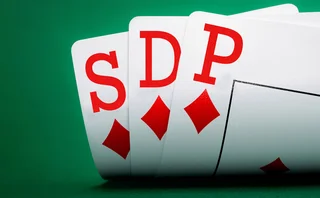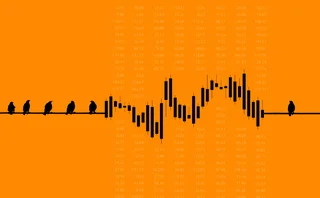
Open interest on E-mini futures surges; S&P 500 vol relents
Open interest on Nasdaq 100 and S&P E-mini futures contracts, electronically traded index futures and options that are smaller than standard futures contracts, has increased by 63% and 15%, respectively, since October. The ratio of open interest to volume for these contracts is also increasing, suggesting that institutions are making increased use of E-minis, according to Goldman Sachs equity derivatives research.
"The ability to trade E-mini S&P MidCap 400 futures will provide individuals and smaller institutions with access to an important portion of the US equity market," said Satish Nandapurkar, a managing director in products and services at the CME. These contracts will be traded on the CME’s Globex trading system and will be sized at $100 times the S&P MidCap 400 index price – or one-fifth of the standard size middle capitalisation futures contract.
Meanwhile, the S&P 500 skew – 25 delta put minus 25 delta call volatility - has finally eased to around 6%. The skew peaked at 9.3% in late September on the back of the equity market downturn, when investors rushed to buy out-of-the-money put options for downside protection, and had traded above 7% until a month ago. A main driver of the shift in the skew was a sharp decline in S&P 500 average stock vol. For example, vol for three-month options declined during November, nearly reaching levels experienced in the early summer – the lowest vols since before the 1998 Russian default crisis, according to Goldman Sachs.
In Europe, implied vol fell most noticeably on the Euro Stoxx 50 and Dax. The spread between at-the-money options and out-of-the-money puts fell by one point. In general, the reduction in the implied vol skew indicates reduced risk aversion in Europe. The collapse in the skew and the fall in implied vol has made zero-premium collars an attractive trade on some European indexes, according to Goldman Sachs.
Only users who have a paid subscription or are part of a corporate subscription are able to print or copy content.
To access these options, along with all other subscription benefits, please contact info@risk.net or view our subscription options here: http://subscriptions.risk.net/subscribe
You are currently unable to print this content. Please contact info@risk.net to find out more.
You are currently unable to copy this content. Please contact info@risk.net to find out more.
Copyright Infopro Digital Limited. All rights reserved.
You may share this content using our article tools. Printing this content is for the sole use of the Authorised User (named subscriber), as outlined in our terms and conditions - https://www.infopro-insight.com/terms-conditions/insight-subscriptions/
If you would like to purchase additional rights please email info@risk.net
Copyright Infopro Digital Limited. All rights reserved.
You may share this content using our article tools. Copying this content is for the sole use of the Authorised User (named subscriber), as outlined in our terms and conditions - https://www.infopro-insight.com/terms-conditions/insight-subscriptions/
If you would like to purchase additional rights please email info@risk.net
More on Markets
Banks mull whether to stick or twist with SDPs
Fewer providers are going all-in on single-dealer platforms, which may lead to consolidation
Market for ‘orphan’ hedges leaves some borrowers stranded
Companies with private credit loans face punitive costs from banks for often imperfect hedges
Green knights? Banks step into struggling carbon credit markets
Clearer global standards and a new exchange may attract dealer entry, but supply and demand challenges remain
Morgan Stanley back on top for US insurer FX forwards trades
Counterparty Radar: Bank added $1.7bn with Mass Mutual in Q4 to overtake Citi as biggest dealer
Euronext microwave link aims to cut HFT advantage in Europe
Exchange plans to level playing field between prop firms and banks in cash equities with cutting edge tech
As dispersion hikes in price, equity traders slice and dice
Banks tout alternative versions of relative value vol strategy, including reverse dispersion
Crédit Agricole hires head of USD swaps and UST trading
John O’Callaghan joins French bank in New York from Garda Capital
Hidden Road ready for rush hour after FCM approval
Prime broker is trading “trillions” of notional with “a few hundred” counterparties in FX and crypto
Most read
- Top 10 operational risks for 2024
- The American way: a stress-test substitute for Basel’s IRRBB?
- Filling gaps in market data with optimal transport







